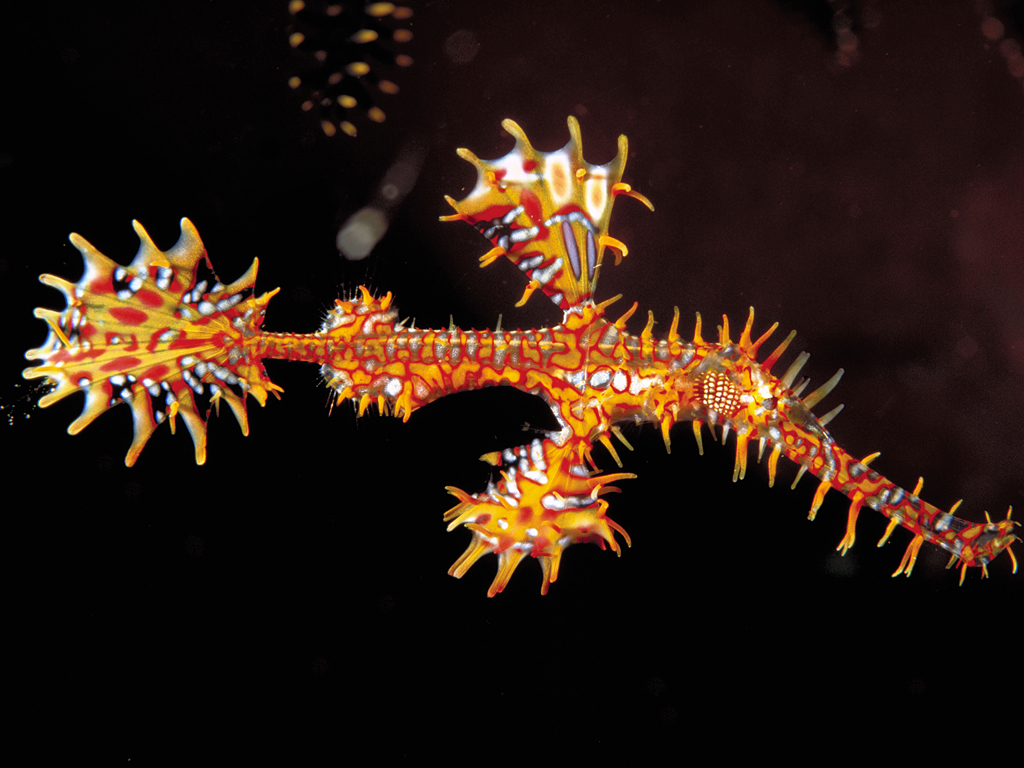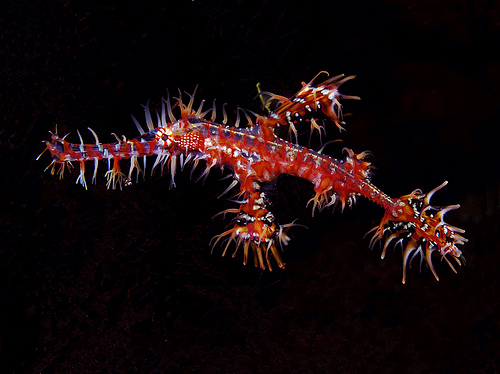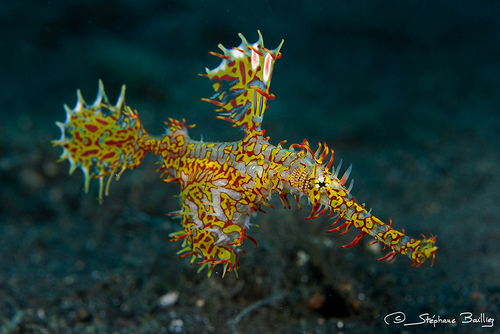
Solenostomus paradoxus
FAMILY
Solenostomidae
TAXONOMY
Fistularia paradoxa Pallas, 1770, Indonesia.
OTHER COMMON NAMES
English: Harlequin ghost pipefish.
PHYSICAL CHARACTERISTICS
A morphologically remarkable fish. Body is very slender and
straight, and head is very elongate, about one-third the total
length. Mouth terminal, small, and upturned. Eyes round.
First dorsal fin situated over pelvic fins, with five very long
spines; second dorsal fin more posterior, with 17–23 rays.
Anal fin opposite second dorsal, with 17–22 rays; pectoral
fins inconspicuous, with 24 rays; pelvic fins located just anterior
to the middle of the body, with seven rays; caudal fin
large and spur-shaped when rays are extended. There are numerous
dermal projections on snout, trunk, and tail. Body
encased in 31–35 segmented bony plates. Coloration spectacular
and ornate. Background color varies from white or semitransparent
to black, with elaborate pattern of red, orange,
white, or yellow spots, blotches, and stripes. Reaches some
4.7 in (12 cm).
DISTRIBUTION
Present in much of the Indo-West Pacific Ocean from the Red
Sea and East Africa to the Marshall Islands and New Caledonia;
occurs as far north as southern Japan and as far south as
Australia.
HABITAT
Usually found in coral reef habitats (down to about 115 ft, or
35 m, in depth) among gorgonian corals, weeds, and algae or
with crinoids over sand, along reef edges, or in sheltered
coastal waters and estuaries.
BEHAVIOR
Typically a solitary species, but small groups of up to six individuals
have been observed. This species is highly camouflaged,
blending in very well with many different backgrounds. Young
are mostly pelagic, but adults are more benthic; post-pelagic
specimens are more transparent. Individuals may hover in a
near vertical position when they are among gorgonians or
other substrates.
FEEDING ECOLOGY AND DIET
Feeds on mysids, small shrimps, and other benthic crustaceans.
Predators unknown but presumably larger reef-dwelling fishes.
REPRODUCTIVE BIOLOGY
In contrast to other syngnathoids, females carry the brood in a
pouch that is formed by the enlarged pelvic fins (which are
missing from other syngnathoids). Eggs are numerous, small,
spherical, and somewhat transparent. Females fan the eggs by
opening and closing their pelvic fins. Young are expelled from
the pouch at birth. Other details concerning their reproduction
are unknown.
CONSERVATION STATUS
Not listed by the IUCN.
SIGNIFICANCE TO HUMANS
Sometimes kept as an aquarium fish; otherwise this species has
no commercial value.
Other popular Animals
Photo Gallery of - Ornate ghost pipefish





 Animalia Life
Animalia Life